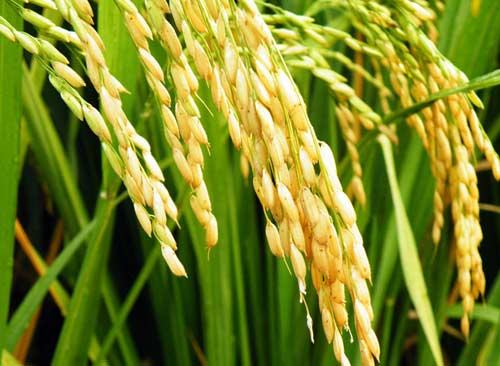当前位置: Language Tips> 新闻播报

A rare indigenous rice species, which almost became extinct in the 1970s, is being revived in Hebei province.
The variety, known as kermes rice for its red color similar to the dyestuff of the same name, has a history of more than 300 years and was once offered to the imperial court as a tribute during the Qing Dynasty (1644-1911).
"It has not been easy, but I have developed more than 5 hectares of the crop since I got a handful of about 300 seeds from my friend Li Ming in Tangshan seven years ago," said Zheng Hehai, head of Tangshan Daoxiang Rice Co.
In the 1970s, farmers turned away from kermes rice because of low yield and stopped planting the variety completely when it was banned by the Hebei government. But Li's father secretly hid some of the rice in his home. In 1984, Li found the rice and sowed the few dozen seeds that remained. The harvest became the seed source for current crops of kermes rice.
One of 140,000 rice varieties in the world, kermes is indigenous to eastern Hebei. The plant is 30 cm taller than most rice species and is vulnerable to stalk-leaning. Its output is about 1,350 kg per hectare, compared with more than 6,000 kg for common varieties of rice, Zheng said.
But all that has changed since the rare rice caught the attention of the Rice Research Institute of Hebei Agriculture and Forestry Academy.
Improved kermes rice, which will be planted next year on Zheng's farm, will be shorter, 120 cm to 150 cm, and its growth period extended by 15 days. These changes will make the variety more economical to farm, while maintaining its taste.
Enthusiasts of the strain say there are good reasons to be patient with it.
Kermes rice contains 2.5 times more amino acid content than general rice, which can help the production of proteins, and can increase levels of hemoglobin in the blood, allowing the body to better transfer oxygen from the lungs, said Chen Hongcun, an agricultural official in Tangshan.
"Unlike genetically modified rice, kermes is an original species left by our ancestors with no food safety concerns," Chen added.
In Yutian county, a kermes cooperative was established in 2010.
Output has increased to 3,000 kg per hectare this year from 750 kg three years ago and sold for 200 yuan ($32.50) per kg in 2012, said Wang Huichuan, a farmer and member of the cooperative in Liangjiadian township. One kilogram of ordinary rice sells for 4 yuan to 6 yuan in Chinese markets.
Even after labor and equipment costs, each hectare of kermes rice can net 2,000 yuan, several times more than other quality rice, said Wang, who estimates that the price for kermes rice will remain stable this year.
Zheng plans to sell about 500 kg this year and keep the rest for further research and planting next year. He said his farm only uses organic fertilizers.
He receives a government subsidy of 3,000 yuan per hectare and is confident that the rare variety will soon be on more dinner tables.
Questions:
1. What kind of rice is making a comeback?
2. What gives it its name?
3. Where are farmers planting this crop?
Answers:
1. Kermes rice.
2. A red color similar to the dyestuff of the same name.
3. Hebei province.
(中国日报网英语点津 丹妮 编辑)

About the broadcaster:
Nelly Min is an editor at China Daily with more than 10 years of experience as a newspaper editor and photographer. She has worked at major newspapers in the U.S., including the Los Angeles Times and the Detroit Free Press. She is also fluent in Korean.
关注和订阅


电话:8610-84883645
传真:8610-84883500
Email: languagetips@chinadaily.com.cn